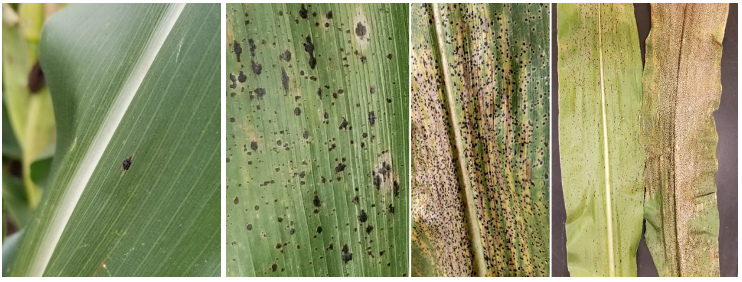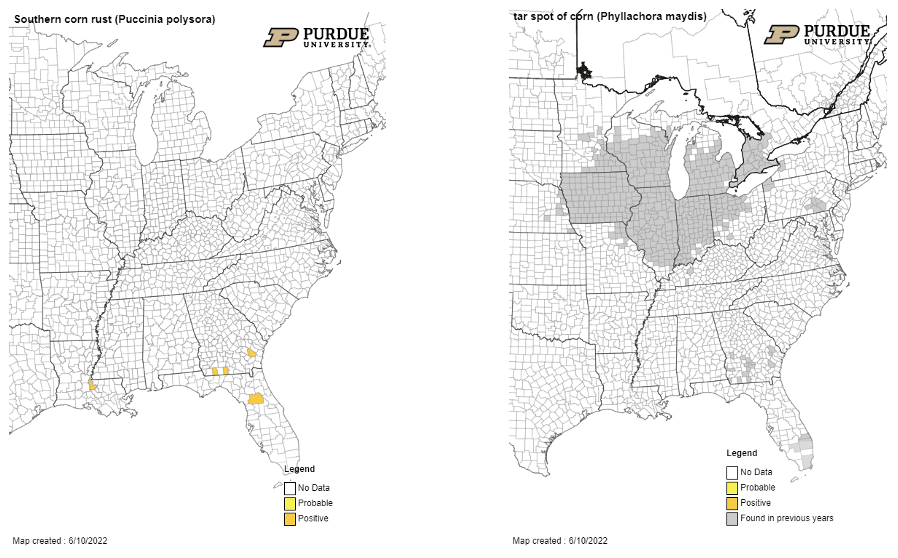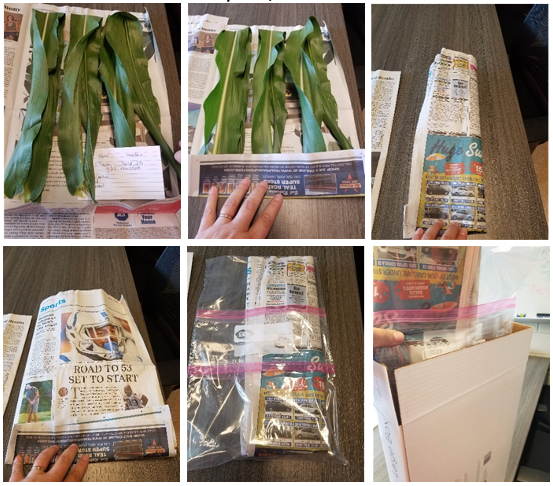It is important to monitoring for diseases to make an informed decision if a fungicide is necessary. As a reminder for disease to occur three things need to be present; 1. Virulent Pathogen, 2. Susceptible Host, and 3. Favorable Environment.
Foliar diseases in corn that we monitor in Indiana include gray leaf spot, northern corn leaf blight, northern corn leaf spot, and tar spot (figure 1 and 2).

Figure 1. Examples of A- gray leaf spot, B-northern corn leaf blight, C-northern corn leaf spot lesions and D-southern rust on corn. (Photo Credits: Darcy Telenko)

Figure 2. Corn leaves infected by tar spot. Infection can range from mild to severe on a leaf. The spots will be raised (bumpy to the touch) and will not rub off. In addition, they may be surround by a tan or brown halo, and high severity can lead to a rapid blighting of the leaf. (Photo Credits: Darcy Telenko)
A few questions to think about when scouting and looking for disease:
- What is the disease history in the field? How much residue is still present? (What happened in previous years, if you have a 2-year rotation?)
- What growth stage is the field? Early planting vs. late
- Is irrigation being applied? How much and how often? If water is being applied, it can change the environmental conditions and disease risk in a field.
See the forecast from the Tarspotter App https://ipcm.wisc.edu/apps/tarspotter/

Figure 3. June 10, 2022 maps of southern rust (left) and tar spot (right). We will be watching southern rust to see when it moves into our neighbors to the south. When we start hearing positive reports out of Missouri or Kentucky need to watch southern Indiana closely.
These maps are live that will be updated when a positive county confirmation is detected. If you are interested in up-to-date information on the current detection of these diseases, the maps are available on the front page of our Extension website https://extension.purdue.edu/fieldcroppathology/.
Should I be putting out a fungicide?
Research has shown the best return on investment in making a fungicide application in corn and soybean occurs when the fungal diseases are active in the corn canopy. It is important to keep scouting.
Based on our research, to minimize the impact of tar spot on crop yield we need to be protecting the ear leaf and above until the corn reaches black layer. In our fungicide timing trials applications made at VT/R1 (tassel /silk) to R2 (blister) have been the optimum timings at controlling tar spot, but we did see that once the fungicide ran out of steam (3-week window) tar spot began to pick up. A well-timed, informed fungicide application will be important to reduced disease severity when it is needed, and we recommend holding off until the diseases become active and corn is nearing VT/R1 (tassel/silk) or even R2 (blister).
If you suspect tar spot in your fields, please consider submitting samples for confirmation. We are interested in documenting the disease in Indiana, similar to last year. Research funding from the Indiana Corn Marketing Council is supporting sample processing, therefore there will be no charge for corn tar spot or southern rust suspected samples submitted to the clinic.
What to look for: Small, black, raised spots (circular or oval) develop on infected plants, and may appear on one or both sides of the leaves, leaf sheaths, and husks. Spots may be found on both healthy (green) and dying (brown) tissue. Sometime, the black spots may be surrounded by a tan or brown halo; this is especially obvious on healthy leaves (see Figure 2).
I want to ask before you submit a sample you do a quick and dirty “scratch test” to see if you can rub the spot off the leaf, especially if you have leaves with just a few small spots. I have been successful in detecting these false spots by using my nail to scratch as the suspect lesion. This is a quick way to check, but as always if you are unsure send me an image or the sample to the Purdue Plant Pest Diagnostic Lab. Please collect several leaves showing the symptoms and send them with a PPDL form https://ag.purdue.edu/btny/ppdl/Documents/Forms/PPDL-Form_13MAY15FILLABLE.pdf.
Mail to: Plant and Pest Diagnostic Laboratory, LSPS-Room 116, Purdue University, 915 W. State Street, West Lafayette, Indiana 47907-2054.
The lab is operating and the building is open, but the lab door is remaining locked. If dropping off a sample is more convenient than shipping, please call or email the lab prior to stopping by: Phone – 765-494-7071; Email – ppdl-samples@purdue.edu.
If you have any questions please contact Darcy Telenko (dtelenko@purdue.edu) or call 764-496-5168 or PPDL (ppdl-samples@purdue.edu) or call 765-494-7071
General resources for all field crops:
Purdue Field Crop Pathology Extension site: https://extension.purdue.edu/fieldcroppathology/
Crop Protection Network: https://cropprotectionnetwork.org/
How to collect foliar disease leaf samples:
Items to have on hand in your truck or car: cooler with ice pack, gallon plastic bags, marker, notebook paper, and newspaper.
- When scouting a field and you identify a potential sample please try to grab 4-6 leaves from that field that are exhibiting the symptoms.
- Take a quick image of the diseased leaf to document (most images will also give you a GPS location if turned on)
- Document field location (address, county and GPS location), in addition if possible hybrid/variety, other management practices and or field comments. Fill out a sample submission form https://ag.purdue.edu/btny/ppdl/Documents/Forms/PPDL-Form_13MAY15FILLABLE.pdf
If you have multiple samples please try to include as much information as possible to help us distinguish between samples.
- Either fold or wrap the corn leaves flat in a piece of newspaper (this will keep the sample from molding especially if waiting to send for a few days).
- Once wrapped in the newspaper you can place in a plastic bag. It is possible to layer leaves from different fields into on bag. Please note this on the sample bag if it does contain multiple locations. (See images below).
- These samples then can be stored in a cool place (cooler with ice packs) or refrigerator until shipped.
- Make sure to include your contact information in case we have further questions about the sample.
- Mailing samples: The PPDL is not open on the weekend. Ship early in the week (Monday-Wednesday) using a next day deliver option to make sure you sample gets to us before the For Thursday shipments DO NOT use USPS overnight delivery. Your package may arrive at Purdue’s central receiving dock by Friday but will not get to our lab by close of business on Friday. Instead use only UPS or FedEx if shipping on Thursday.
Ship sample to:
Plant and Pest Diagnostic Laboratory
LSPS-Room 116, Purdue University
915 W. State Street
West Lafayette, Indiana 47907-2054



